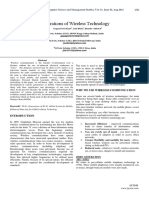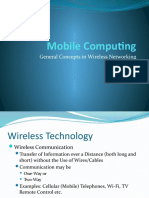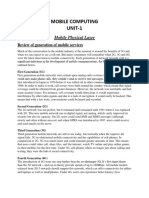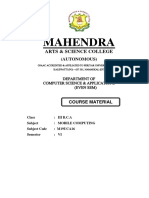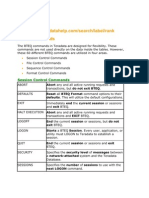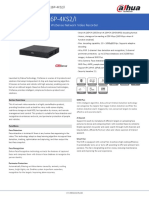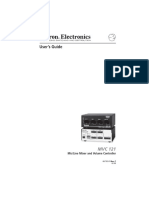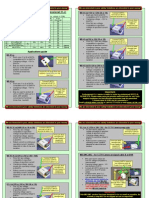WIRELESS/MOBILE COMPUTING TECHNOLOGIES
Computing Technologies are the technologies that are used to manage, process, and
communicate the data. Wireless simply means without any wire i.e. connecting with other
devices without any physical connection. Wireless computing is transferring the data or
information between computers or devices that are not physically connected to each other and
having a “wireless network connection”. For example, mobile devices, Wi-Fi, wireless printers
and scanners, etc. Mobiles are not physically connected but then too we can transfer data.
Mobile is a computing device that not require any network connection or any connection to
transfer data or information between devices. For example laptops, tablets, smartphones, etc.
Mobile computing allows transferring of the data/information, audio, video, or any other
document without any connection to the base or central network. These computing devices are
the most widely used technologies nowadays.
There are some wireless/mobile computing technologies given below:
1. Global System for Mobile Communications (GSM) :
GSM is a Current circuit-switched wireless data communication technology. It is
established in Europe by ETSI (European Telecommunications Standards Institute) in the
mid-1980s. GSM network has 4 different parks that who’s functions are different: Mobile
Station, BSS (Base Station Subsystem), NSS (Network Switching Subsystem), OSS
(Operation and Support Subsystem).
2. Code-Division Multiple Access (CDMA) :
CDMA is a type of wireless computing technology. It is developed during World War II.
This technology is mostly used as it provides better network quality, more storage
capacity for voice and data communications than TDMA, decreases system noise and
interference using power control, provides more security by encoding the user
transmission data into a unique code.
CDMA does not provide any user with a specific frequency instead utilizes the entire
frequency spectrum available for transmission. It operates in the frequency range of 800
MHz to 1.9 GHz. It uses Soft Handoff that reduces signal breaks.
� 3. Wireless in Local Loop (WLL) :
WLL is a widely used technology for wireless communication systems. It is also called a
Fixed Wireless Loop. WLL is very easy to develop and less time is required to install,
very cost-effective as wireless systems are less expensive because the cost of cable
installation is not added.
WLL allows users to connect to the local telephone station using a wireless link and
provides advanced features of customer service. It provides high-quality data
transmission and a high data rate. Generally, two types of WLL techniques are available:
Local Multipoint Distribution Service (LMDS) and Multichannel Multipoint Distribution
Service (MMDS).
4. General Packet Radio Service (GPRS) :
GPRS is a type of Packet-based Wireless communication technology. It is established by
ETSI (European Telecommunications Standards Institute). GPRS can achieve a data
transfer rate of up to 114Kbps. It is very cost-effective, highly stable, can achieve a
maximum data rate of up to 114Kbps (Kilobits per second). It supports Internet Protocol
(IP), X.25 (standard protocol for packet-switched data communication), Point-to-Point
protocol (PPP), and based on Gaussian minimum-shift keying (GMSK) which is a
modulation technique.
The Gateway GPRS Service Node (GGSN) and the Serving GPRS Service Node (SGSN) are
the two core modules required to enable GPRS on GSM network or TDMA network.
5. Short Message Service (SMS) :
SMS is originally created for a phone/mobile that uses GSM Global System for Mobile
communication). This service is used to send text messages even without the Internet
connection between two or more mobile devices. This technique is very easy, user-
friendly, comfortable and the most effective means of wireless communication.
In this service, less time is required for communication. It does not require any Internet
connection for sending text messages. It allows the transmission of short messages i.e. up to 160
�characters in length. SMS uses standardized communication protocols. SMS is received by Short
Message Service Center (SMSC).
Software packages
There are several software packages that support mobile and wireless computing, each catering
to different needs and functionalities. Here are a few notable ones:
1. Intel® PROSet/Wireless Software: This software is used to manage wireless
connections on Intel-based systems
2. Mobile Device Management (MDM) Software: Solutions like Microsoft Intune,
VMware AirWatch, and IBM MaaS360 help IT administrators manage, monitor, and
secure mobile devices within an organization.
3. Wireless Network Management Software: Tools such as Cisco Wireless Control
System (WCS) and Aruba AirWave provide comprehensive management of wireless
networks, including monitoring, troubleshooting, and optimizing network performance2.
4. Development Frameworks: For creating mobile applications, frameworks like React
Native, Flutter, and Xamarin are popular.
5. Communication Protocols: Software supporting protocols like GSM, CDMA, and Wi-Fi
are essential for mobile and wireless communication












